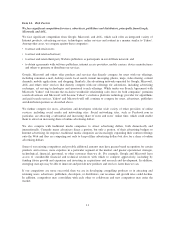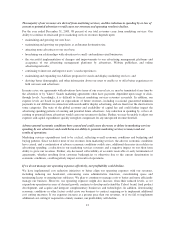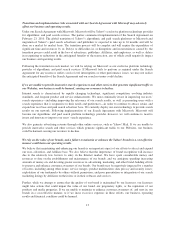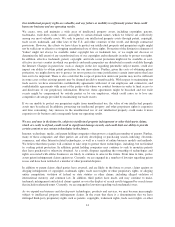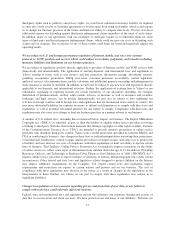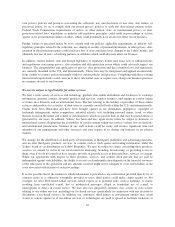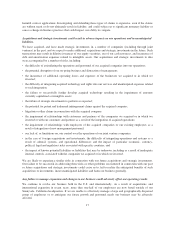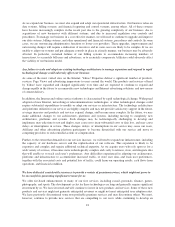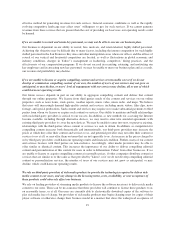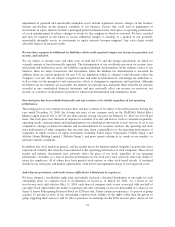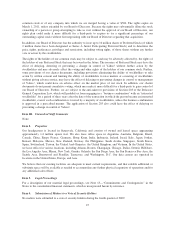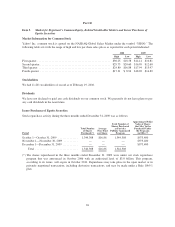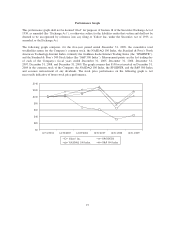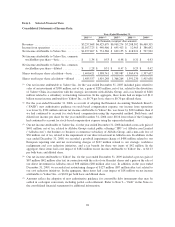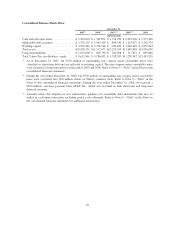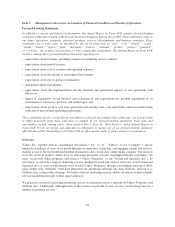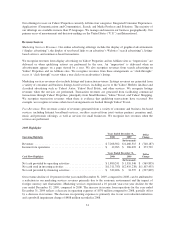Yahoo 2009 Annual Report Download - page 29
Download and view the complete annual report
Please find page 29 of the 2009 Yahoo annual report below. You can navigate through the pages in the report by either clicking on the pages listed below, or by using the keyword search tool below to find specific information within the annual report.versions. We may be unable to attract and retain a substantial number of alternative device manufacturers,
distributors, content providers, and users to our services, or to capture a sufficient share of an increasingly
important portion of the market for these services, and, therefore, we may be unsuccessful in attracting both
advertisers and premium service subscribers to these services.
To the extent that an access provider or device manufacturer enters into a distribution arrangement with one of our
competitors (or as our competitors design mobile devices and mobile device operating systems), we face an
increased risk that our users will favor the services or properties of that competitor. The manufacturer or access
provider might promote a competitor’s services or might impair users’ access to our services by blocking access
through their devices or by not making our services available in a readily-discoverable manner on their devices. If
competitive distributors impair access to our services, or if they simply are more successful than our distributors in
developing compelling products that attract and retain users or advertisers, then our revenues could decline.
In the future, as new methods for accessing the Internet and our services become available, including through
alternative devices, we may need to enter into amended distribution agreements with existing access providers,
distributors and manufacturers to cover the new devices and new arrangements. We face a risk that existing and
potential new access providers, distributors, and manufacturers may decide not to offer distribution of our
services on reasonable terms, or at all. If we fail to obtain distribution or to obtain distribution on terms that are
reasonable, we may not be able to fully execute our business plan.
In international markets, we compete with local Internet service providers that may have competitive
advantages.
In a number of international markets, especially those in Asia, Europe, and Latin America, we face substantial
competition from local Internet service providers and other portals that offer search, communications, and other
commercial services. Many of these companies have a dominant market share in their territories and are owned by
local telecommunications providers which give them a competitive advantage. Local providers of competing online
services may also have a substantial advantage over us in attracting users in their country due to more established
branding in that country, greater knowledge with respect to the tastes and preferences of users residing in that
country, and/or their focus on a single market. Further, the local providers may have greater regulatory and
operational flexibility than Yahoo! due to the fact that we are subject to both U.S. and foreign regulatory
requirements. We must continue to improve our local offerings, become more knowledgeable about our local users
and their preferences, deepen our relationships with our local users as well as increase our branding and other
marketing activities in order to remain competitive and strengthen our international market position.
Our international operations are subject to increased risks which could harm our business, operating results,
and financial condition.
In addition to uncertainty about our ability to continue to generate revenues from our foreign operations and
expand our international market position, there are risks inherent in doing business internationally, including:
• trade barriers and changes in trade regulations;
• difficulties in developing, staffing, and simultaneously managing a large number of varying foreign operations
as a result of distance, language, and cultural differences;
• stringent local labor laws and regulations;
• longer payment cycles;
• credit risk and higher levels of payment fraud;
• profit repatriation restrictions, and foreign currency exchange restrictions;
• political or social unrest, economic instability, repression, or human rights issues;
21


